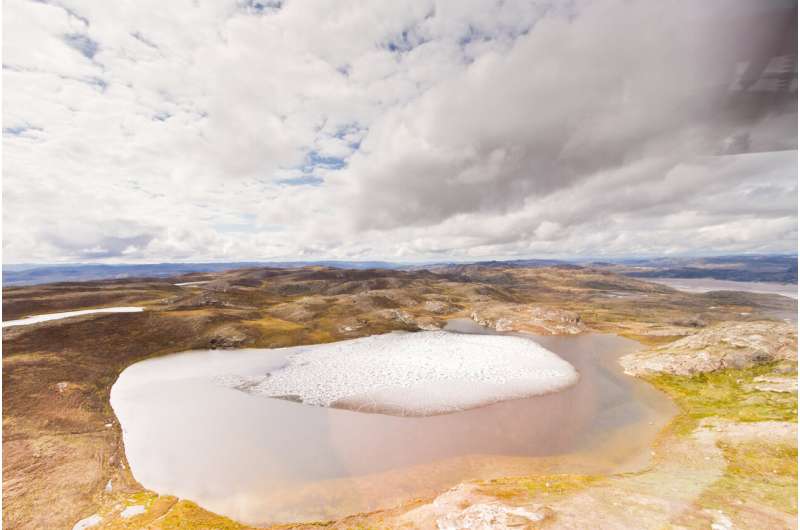La Groenlandia si è sciolta circa 416.000 anni fa, dimostrando un elevato rischio di causare oggi l'innalzamento del livello del mare.

20 luglio 2023
Questo articolo è stato revisionato secondo il processo editoriale e le politiche di Science X. Gli editori hanno evidenziato i seguenti attributi, garantendo la credibilità del contenuto:
- fatto-vero
- pubblicazione sottoposta a peer-review
- fonte affidabile
- corretta
da Università del Vermont
Durante la Guerra Fredda, una missione segreta dell'esercito degli Stati Uniti, a Camp Century nel nord-ovest della Groenlandia, ha perforato 4560 piedi di ghiaccio sull'isola ghiacciata e ha continuato a perforare per estrarre un tubo di suolo e roccia lungo dodici piedi dal sottosuolo sotto il ghiaccio. Questo sedimento ghiacciato è stato poi perso in un congelatore per decenni. È stato accidentalmente riscoperto nel 2017 e si è scoperto che conteneva non solo sedimento, ma anche foglie e muschio, resti di un paesaggio privo di ghiaccio, forse una foresta boreale.
Ma quanto tempo fa stavano crescendo quelle piante - dove oggi si estende un lenzuolo di ghiaccio spesso due miglia e tre volte la dimensione del Texas?
Un team internazionale di scienziati è rimasto stupito nel scoprire che la Groenlandia era una terra verde solo 416.000 anni fa (con un margine di errore di circa 38.000 anni). Il loro nuovo studio è stato pubblicato sulla rivista Science.
Fino a poco tempo fa, i geologi credevano che la Groenlandia fosse una fortezza di ghiaccio, in gran parte non fusa da milioni di anni. Ma due anni fa, utilizzando il nucleo di ghiaccio di Camp Century riscoperto, questo team di scienziati ha dimostrato che si è probabilmente sciolto meno di un milione di anni fa. Altri scienziati, lavorando nel centro della Groenlandia, hanno raccolto dati che dimostrano che il ghiaccio si è sciolto almeno una volta negli ultimi 1,1 milioni di anni - ma fino a questo studio, nessuno sapeva esattamente quando il ghiaccio fosse scomparso. Video di modelli 3D in rotazione del nucleo di ghiaccio e sedimenti di Camp Century costruiti da fotografie. Questo nucleo ha aiutato a rivelare che una grande porzione della Groenlandia si è sciolta circa 416.000 anni fa diventando una tundra priva di ghiaccio, come mostra un nuovo studio pubblicato sulla rivista Science. I risultati contribuiscono a ribaltare una visione precedente secondo cui gran parte del lenzuolo di ghiaccio della Groenlandia è durato per la maggior parte degli ultimi due milioni e mezzo di anni. Invece, un riscaldamento moderato ha portato a un drammatico scioglimento. Questa scoperta indica che il lenzuolo di ghiaccio sulla Groenlandia potrebbe essere più sensibile al cambiamento climatico causato dall'uomo di quanto si pensasse in precedenza e sarà vulnerabile a uno scioglimento irreversibile e rapido nei prossimi secoli. Credit: Andrew Christ/UVM
Utilizzando tecnologie avanzate di luminescenza e analisi di isotopi rari, il team ha creato un'immagine più nitida: ampie porzioni del lenzuolo di ghiaccio della Groenlandia si sono sciolte molto più di recente di un milione di anni fa. Il nuovo studio presenta prove dirette che il sedimento appena sotto il lenzuolo di ghiaccio è stato depositato dall'acqua che scorreva in un ambiente privo di ghiaccio durante un periodo di riscaldamento moderato chiamato Stadio Isotopico Marino 11, da 424.000 a 374.000 anni fa. Questo scioglimento ha causato un aumento del livello del mare di almeno cinque piedi in tutto il mondo.
"È davvero la prima prova schiacciante che gran parte del lenzuolo di ghiaccio della Groenlandia è scomparso quando si è riscaldato", afferma Paul Bierman, scienziato dell'Università del Vermont, che ha co-diretto il nuovo studio insieme all'autore principale Drew Christ, un geoscientista post-dottorato che ha lavorato nel laboratorio di Bierman, il professore Tammy Rittenour dell'Università Statale dello Utah e altri diciotto scienziati provenienti da tutto il mondo.
Comprendere il passato della Groenlandia è fondamentale per prevedere come il suo enorme lenzuolo di ghiaccio risponderà al riscaldamento climatico in futuro e quanto velocemente si scioglierà. Poiché circa 23 piedi di aumento del livello del mare sono legati al ghiaccio della Groenlandia, ogni regione costiera del mondo è a rischio. Il nuovo studio fornisce prove solide e precise che la Groenlandia è più sensibile al cambiamento climatico di quanto si pensasse in precedenza e è a rischio di sciolgimento irreversibile.
"Il passato della Groenlandia, conservato in 12 piedi di suolo congelato, suggerisce un futuro caldo, umido e in gran parte privo di ghiaccio per il pianeta Terra", afferma Bierman, geoscientista presso la Rubenstein School of the Environment and Natural Resources dell'Università del Vermont e membro dell'Istituto Gund per l'Ambiente, "a meno che non si possa abbassare drasticamente la concentrazione di anidride carbonica nell'atmosfera".
Il nuovo studio del team in Science, unito al loro lavoro precedente, sta portando a una radicale e preoccupante riconsiderazione della storia del lenzuolo di ghiaccio della Groenlandia. "Abbiamo sempre supposto che il lenzuolo di ghiaccio della Groenlandia si sia formato circa due milioni e mezzo di anni fa - e sia stato lì tutto il tempo e che sia molto stabile", afferma Tammy Rittenour, scienziata presso l'Università Statale dello Utah e co-autrice del nuovo studio. "Forse i bordi si sono sciolti, o con una maggiore caduta di neve si è un po' ingrossato - ma non scompare e non si scioglie in modo drammatico. Ma questa ricerca dimostra che lo ha fatto".
At Rittenour's lab, sediment from the Camp Century core was examined for what is called a 'luminescence signal.' As bits of rock and sand are transported by wind or water, they can be exposed to sunlight—which, basically, zeros out any previous luminescence signal—and then re-buried under rock or ice. In the darkness, over time, minerals of quartz and feldspar in the sediment accumulate freed electrons in their crystals.
In a specialized dark room, Rittenour's team took pieces of the ice core sediment and exposed them to blue-green or infrared light, releasing the trapped electrons. With some advanced tools and measures, and many repeated tests, the number of released electrons forms a kind of clock, revealing with precision the last time these sediments were exposed to the sun. 'And the only way to do that at Camp Century is to remove a mile of ice,' says Rittenour, 'Plus, to have plants, you have to have light.'
These powerful new data were combined with insight from Bierman's UVM lab. There, scientists study quartz from the Camp Century core. Inside this quartz, rare forms—called isotopes—of the elements beryllium and aluminum build up when the ground is exposed to the sky and can be hit by cosmic rays. Looking at ratios of beryllium and other isotopes gave the scientists a window onto how long rocks at the surface were exposed vs. buried under layers of ice. This data helped the scientists show that the Camp Century sediment was exposed to the sky less than 14,000 years before it was deposited under the ice, narrowing down the time window when that portion of Greenland must have been ice-free.
Camp Century was a military base hidden in tunnels under the Greenland ice sheet in the 1960s. One strategic purpose of the camp was a top-secret operation, called Project Iceworm, to hide hundreds of nuclear missiles under the ice near the Soviet Union. As cover, the Army claimed the camp was an Arctic science station.
The missile mission was a bust, but the science team did complete first-of-its-kind research, including drilling a nearly mile-deep ice core. The Camp Century scientists were focused on the ice itself—part of an effort to understand Earth's past ice ages and warm periods, the interglacials. They took little interest in the twelve feet of sediment gathered from beneath their ice core.
Then, in a bizarre story, the ice core was moved in the 1970s from a military freezer to the University at Buffalo—and then to another freezer in Denmark in the 1990s. There it was lost for decades—until it was found again when the cores were being moved to a new freezer. More about how the core was lost, rediscovered in some cookie jars, and then studied by an international team gathered at the University of Vermont's Gund Institute for Environment can be read here: Secrets Under the Ice.
Camp Century is 138 miles inland from the coast and only 800 miles from the North Pole; the new Science study shows that the region entirely melted and was covered with vegetation during Marine Isotope Stage 11, a long interglacial with temperatures similar to or slightly warmer than today. With this information, the team's models show that, during that period, the ice sheet melted enough to cause at least five feet, and perhaps as much as 20 feet, of sea-level rise.
The research lines up with findings from two other ice cores collected in 1990s from the center of Greenland. Sediment from these cores also suggest that the giant ice sheet melted in the recent geologic past. The combination of these earlier cores with the new insight from Camp Century reveal the fragile nature of the entire Greenland ice sheet—in the past (at 280 parts per million of atmospheric CO2 or less) and today (422ppm and rising).
'If we melt just portions of the Greenland ice sheet, the sea level rises dramatically,' says Utah's Tammy Rittenour. 'Forward modeling the rates of melt, and the response to high carbon dioxide, we are looking at meters of sea level rise, probably tens of meters. And then look at the elevation of New York City, Boston, Miami, Amsterdam. Look at India and Africa—most global population centers are near sea level.'
'Four-hundred-thousand years ago there were no cities on the coast,' says UVM's Paul Bierman, 'and now there are cities on the coast.'
Journal information: Science
Provided by University of Vermont




